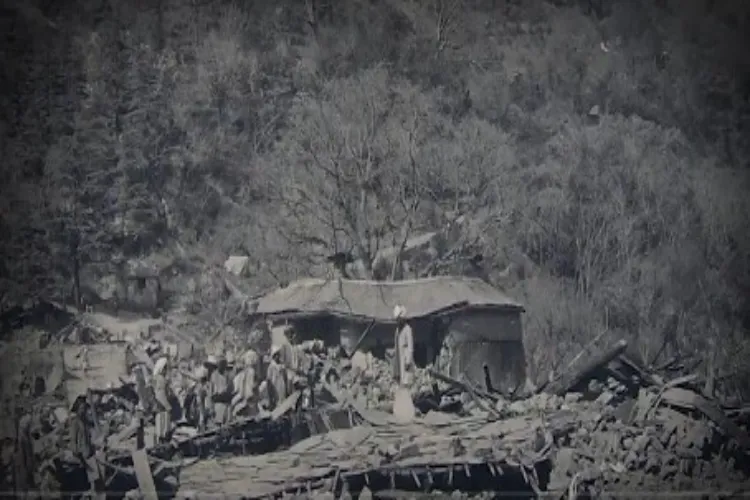
Dharamsala
On this day in 1905, the Kangra Valley in Himachal Pradesh was devastated by a 7.8 magnitude earthquake, one of the deadliest in the 20th century, claiming over 20,000 lives and destroying 100,000 buildings. This was one of the first in the era of instrumental seismology.
April 4 marked the 120th anniversary of the earthquake.
According to the National Institute of Disaster Management, more than 20,000 people lost their lives and 100,000 buildings were destroyed in the quake that occurred at 5.20 a.m., the black day in the Himalayan history.
It urges everyone to learn from past events and act today for a safer tomorrow. “Together, we can reduce risks and save lives!”
Seismologists believe the areas that have experienced great or large earthquakes in the past may experience big events in the future as well.
According to a research paper, the recurrence of an earthquake similar or bigger than the 1905 Kangra earthquake indicates the possibility of a major earthquake at 50- to 200-year intervals.
Sounding an alarm, it says most of the (post-1905 quake) buildings are built on surface material, which is colluvium. The growing number of multi-storied buildings built on unstable slopes and without following building codes is a major concern for the government.
Interestingly, the Kangra Fort, which is said to have withstood several enemy attacks, was damaged massively in 1905.
Last year’s April 4 was a wake-up call for local authorities as an earthquake of 5.3 magnitude hit Chamba town, adjoining Kangra district, with strong tremors felt across the state.
A recent visit to the Kangra Valley reveals the mushrooming of illegal constructions in McLeodganj, located in the suburbs of Dharamsala, which is also posing a threat to Tibetan spiritual leader the Dalai Lama’s abode where he has been staying since 1960 after he fled Tibet amid Chinese persecution in 1959.
The town is also the seat of the Tibetan government-in-exile and houses around 16,000 Tibetans.
Experts fear a high-intensity quake can turn the uphill town McLeodganj in Kangra district, known for attracting a steady stream of Tibet enthusiasts, Buddhist scholars, backpackers, and even Hollywood stars, into a tomb of rubble as it falls in seismic zone V.
“You can see massive high-rise commercial concrete structures that are coming up in McLeodganj and its nearby tourist spots like Naddi and Bhagsu despite repeated tremors in the area. When I was a child, McLeodganj was a small, quaint town with monasteries amid the lush deodar pines. Today it is concrete all over, more a buzzing tourist spot,” remarked Tenzin Dorjee, an octogenarian living here since the 1960s.
Dorjee has been living in the quaint town with the snow-clad Dhauladhar ranges in the backdrop along with his family since the Tibetan spiritual leader arrived here.
A devastating earthquake in 1905 severely damaged property in the Kangra region, including St. John’s Church, where many British officials were buried.
Records of the field station of the Wadia Institute of Himalayan Geology, an autonomous research institute of the Department of Science and Technology at McLeodganj, show that several earthquakes have struck this region since 1905.
Prominent among these were the ones on June 15, 1978, and another on April 26, 1986 -- the first of magnitude 5 and the other 5.7 on the Richter scale.
Like Kangra, most buildings elsewhere in Himachal Pradesh, due to illegal construction, are hanging precariously on steep slopes and clinging to one another in the quake-prone erstwhile summer capital of the British, Shimla, and other tourist resorts such as Kasauli, Manali, Palampur, Mandi, and Solan.
Experts warn they cannot withstand a high-intensity quake and can collapse like a house of cards. Besides quakes, cloudbursts and flash floods have also become a regular feature in the hill state in recent years.
The heavy loss of life caused by such calamities can be mainly attributed to the increasing human activity, particularly along the rivers and water channels.
The local authorities are yet to wake up from their slumber, even though most of the picnic spots in the Himalayan state fall in high seismic zones IV-V, suggesting the severest seismic sensitivity.
Advocating sustainable development, the National Green Tribunal and the High Court have time and again rapped the state authorities over their lack of response to the growing unauthorized constructions across Himachal.
Old-timers blame the successive BJP and Congress governments for converting most of the picturesque towns into concrete jungles.
In Sanjauli, a congested locality on Shimla’s outskirts, the dead often have to be lifted out of homes with ropes.
ALSO READ: PM Modi asks Bangladesh's Yunus to avoid rhetoric, protect minorities
The frightening reality of a performance audit in 2017 on disaster management, with a specific focus on earthquake and fire, conducted by the Comptroller and Auditor General (CAG) to ascertain the state’s preparedness says 90 per cent of buildings, mainly houses, in rural areas of the state do not follow safe construction rules.
The construction of buildings and houses in rural areas (89 per cent of total houses) is not regulated by any law. Construction of seismic-resistant buildings in rural areas has, thus, not been ensured as of June 2016, the CAG observed.
